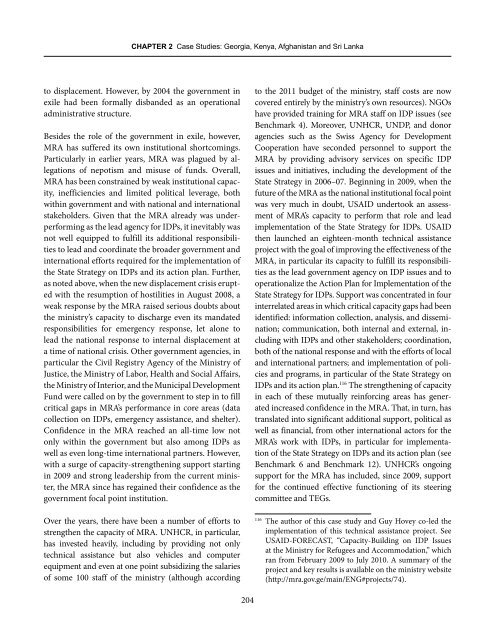From Responsibility to Response: Assessing National - Brookings
From Responsibility to Response: Assessing National - Brookings
From Responsibility to Response: Assessing National - Brookings
You also want an ePaper? Increase the reach of your titles
YUMPU automatically turns print PDFs into web optimized ePapers that Google loves.
CHAPTER 2 Case Studies: Georgia, Kenya, Afghanistan and Sri Lanka<br />
<strong>to</strong> displacement. However, by 2004 the government in<br />
exile had been formally disbanded as an operational<br />
administrative structure.<br />
Besides the role of the government in exile, however,<br />
MRA has suffered its own institutional shortcomings.<br />
Particularly in earlier years, MRA was plagued by allegations<br />
of nepotism and misuse of funds. Overall,<br />
MRA has been constrained by weak institutional capacity,<br />
inefficiencies and limited political leverage, both<br />
within government and with national and international<br />
stakeholders. Given that the MRA already was underperforming<br />
as the lead agency for IDPs, it inevitably was<br />
not well equipped <strong>to</strong> fulfill its additional responsibilities<br />
<strong>to</strong> lead and coordinate the broader government and<br />
international efforts required for the implementation of<br />
the State Strategy on IDPs and its action plan. Further,<br />
as noted above, when the new displacement crisis erupted<br />
with the resumption of hostilities in August 2008, a<br />
weak response by the MRA raised serious doubts about<br />
the ministry’s capacity <strong>to</strong> discharge even its mandated<br />
responsibilities for emergency response, let alone <strong>to</strong><br />
lead the national response <strong>to</strong> internal displacement at<br />
a time of national crisis. Other government agencies, in<br />
particular the Civil Registry Agency of the Ministry of<br />
Justice, the Ministry of Labor, Health and Social Affairs,<br />
the Ministry of Interior, and the Municipal Development<br />
Fund were called on by the government <strong>to</strong> step in <strong>to</strong> fill<br />
critical gaps in MRA’s performance in core areas (data<br />
collection on IDPs, emergency assistance, and shelter).<br />
Confidence in the MRA reached an all-time low not<br />
only within the government but also among IDPs as<br />
well as even long-time international partners. However,<br />
with a surge of capacity-strengthening support starting<br />
in 2009 and strong leadership from the current minister,<br />
the MRA since has regained their confidence as the<br />
government focal point institution.<br />
Over the years, there have been a number of efforts <strong>to</strong><br />
strengthen the capacity of MRA. UNHCR, in particular,<br />
has invested heavily, including by providing not only<br />
technical assistance but also vehicles and computer<br />
equipment and even at one point subsidizing the salaries<br />
of some 100 staff of the ministry (although according<br />
204<br />
<strong>to</strong> the 2011 budget of the ministry, staff costs are now<br />
covered entirely by the ministry’s own resources). NGOs<br />
have provided training for MRA staff on IDP issues (see<br />
Benchmark 4). Moreover, UNHCR, UNDP, and donor<br />
agencies such as the Swiss Agency for Development<br />
Cooperation have seconded personnel <strong>to</strong> support the<br />
MRA by providing advisory services on specific IDP<br />
issues and initiatives, including the development of the<br />
State Strategy in 2006–07. Beginning in 2009, when the<br />
future of the MRA as the national institutional focal point<br />
was very much in doubt, USAID under<strong>to</strong>ok an assessment<br />
of MRA’s capacity <strong>to</strong> perform that role and lead<br />
implementation of the State Strategy for IDPs. USAID<br />
then launched an eighteen-month technical assistance<br />
project with the goal of improving the effectiveness of the<br />
MRA, in particular its capacity <strong>to</strong> fulfill its responsibilities<br />
as the lead government agency on IDP issues and <strong>to</strong><br />
operationalize the Action Plan for Implementation of the<br />
State Strategy for IDPs. Support was concentrated in four<br />
interrelated areas in which critical capacity gaps had been<br />
identified: information collection, analysis, and dissemination;<br />
communication, both internal and external, including<br />
with IDPs and other stakeholders; coordination,<br />
both of the national response and with the efforts of local<br />
and international partners; and implementation of policies<br />
and programs, in particular of the State Strategy on<br />
IDPs and its action plan. 116 The strengthening of capacity<br />
in each of these mutually reinforcing areas has generated<br />
increased confidence in the MRA. That, in turn, has<br />
translated in<strong>to</strong> significant additional support, political as<br />
well as financial, from other international ac<strong>to</strong>rs for the<br />
MRA’s work with IDPs, in particular for implementation<br />
of the State Strategy on IDPs and its action plan (see<br />
Benchmark 6 and Benchmark 12). UNHCR’s ongoing<br />
support for the MRA has included, since 2009, support<br />
for the continued effective functioning of its steering<br />
committee and TEGs.<br />
116 The author of this case study and Guy Hovey co-led the<br />
implementation of this technical assistance project. See<br />
USAID-FORECAST, “Capacity-Building on IDP Issues<br />
at the Ministry for Refugees and Accommodation,” which<br />
ran from February 2009 <strong>to</strong> July 2010. A summary of the<br />
project and key results is available on the ministry website<br />
(http://mra.gov.ge/main/ENG#projects/74).

















